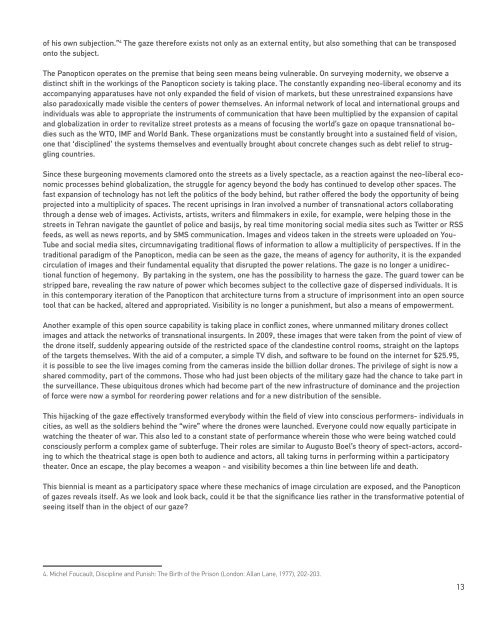KANTUTA QUIROS & ALIOCHA IMHOff - Overlapping Biennial
KANTUTA QUIROS & ALIOCHA IMHOff - Overlapping Biennial
KANTUTA QUIROS & ALIOCHA IMHOff - Overlapping Biennial
Create successful ePaper yourself
Turn your PDF publications into a flip-book with our unique Google optimized e-Paper software.
of his own subjection.” 4 The gaze therefore exists not only as an external entity, but also something that can be transposed<br />
onto the subject.<br />
The Panopticon operates on the premise that being seen means being vulnerable. On surveying modernity, we observe a<br />
distinct shift in the workings of the Panopticon society is taking place. The constantly expanding neo-liberal economy and its<br />
accompanying apparatuses have not only expanded the field of vision of markets, but these unrestrained expansions have<br />
also paradoxically made visible the centers of power themselves. An informal network of local and international groups and<br />
individuals was able to appropriate the instruments of communication that have been multiplied by the expansion of capital<br />
and globalization in order to revitalize street protests as a means of focusing the world’s gaze on opaque transnational bodies<br />
such as the WTO, IMF and World Bank. These organizations must be constantly brought into a sustained field of vision,<br />
one that ‘disciplined’ the systems themselves and eventually brought about concrete changes such as debt relief to struggling<br />
countries.<br />
Since these burgeoning movements clamored onto the streets as a lively spectacle, as a reaction against the neo-liberal economic<br />
processes behind globalization, the struggle for agency beyond the body has continued to develop other spaces. The<br />
fast expansion of technology has not left the politics of the body behind, but rather offered the body the opportunity of being<br />
projected into a multiplicity of spaces. The recent uprisings in Iran involved a number of transnational actors collaborating<br />
through a dense web of images. Activists, artists, writers and filmmakers in exile, for example, were helping those in the<br />
streets in Tehran navigate the gauntlet of police and basijs, by real time monitoring social media sites such as Twitter or RSS<br />
feeds, as well as news reports, and by SMS communication. Images and videos taken in the streets were uploaded on You-<br />
Tube and social media sites, circumnavigating traditional flows of information to allow a multiplicity of perspectives. If in the<br />
traditional paradigm of the Panopticon, media can be seen as the gaze, the means of agency for authority, it is the expanded<br />
circulation of images and their fundamental equality that disrupted the power relations. The gaze is no longer a unidirectional<br />
function of hegemony. By partaking in the system, one has the possibility to harness the gaze. The guard tower can be<br />
stripped bare, revealing the raw nature of power which becomes subject to the collective gaze of dispersed individuals. It is<br />
in this contemporary iteration of the Panopticon that architecture turns from a structure of imprisonment into an open source<br />
tool that can be hacked, altered and appropriated. Visibility is no longer a punishment, but also a means of empowerment.<br />
Another example of this open source capability is taking place in conflict zones, where unmanned military drones collect<br />
images and attack the networks of transnational insurgents. In 2009, these images that were taken from the point of view of<br />
the drone itself, suddenly appearing outside of the restricted space of the clandestine control rooms, straight on the laptops<br />
of the targets themselves. With the aid of a computer, a simple TV dish, and software to be found on the internet for $25.95,<br />
it is possible to see the live images coming from the cameras inside the billion dollar drones. The privilege of sight is now a<br />
shared commodity, part of the commons. Those who had just been objects of the military gaze had the chance to take part in<br />
the surveillance. These ubiquitous drones which had become part of the new infrastructure of dominance and the projection<br />
of force were now a symbol for reordering power relations and for a new distribution of the sensible.<br />
This hijacking of the gaze effectively transformed everybody within the field of view into conscious performers- individuals in<br />
cities, as well as the soldiers behind the “wire” where the drones were launched. Everyone could now equally participate in<br />
watching the theater of war. This also led to a constant state of performance wherein those who were being watched could<br />
consciously perform a complex game of subterfuge. Their roles are similar to Augusto Boel’s theory of spect-actors, according<br />
to which the theatrical stage is open both to audience and actors, all taking turns in performing within a participatory<br />
theater. Once an escape, the play becomes a weapon - and visibility becomes a thin line between life and death.<br />
This biennial is meant as a participatory space where these mechanics of image circulation are exposed, and the Panopticon<br />
of gazes reveals itself. As we look and look back, could it be that the significance lies rather in the transformative potential of<br />
seeing itself than in the object of our gaze?<br />
4. Michel Foucault, Discipline and Punish: The Birth of the Prison (London: Allan Lane, 1977), 202-203.<br />
13


